Sumo!
The National Sport Of Japan
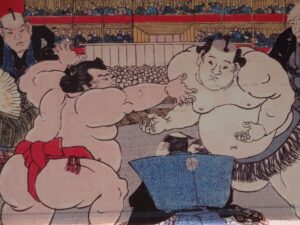
A 41 minute trip on 3 trains to Tokyo and we were at the dedicated Sumo Arena where the Grand Championships are held. One tournament takes place over 15 days and there are six per year, one month on, one month off. Sumo dates back 1,500 years and is believed to have originated as a religious ritual dedicated to the Gods.
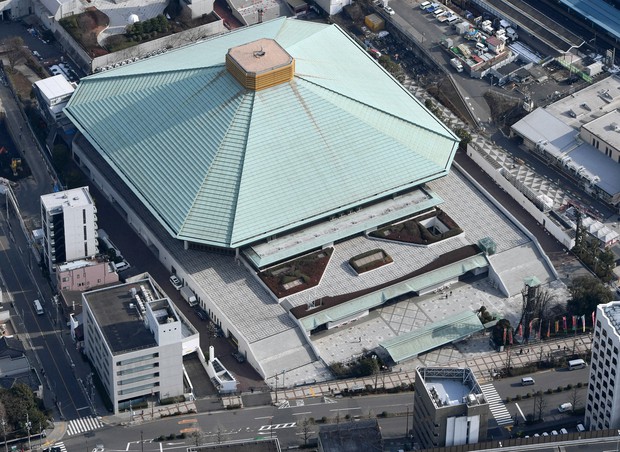
Matches take place on the ‘dohyo’ which is a platform that sits 2′ high and is 18′ square. The match is confined to an inner circle on the dohyo that is roughly 15′ in diameter and covered in a light sprinkle of sand.
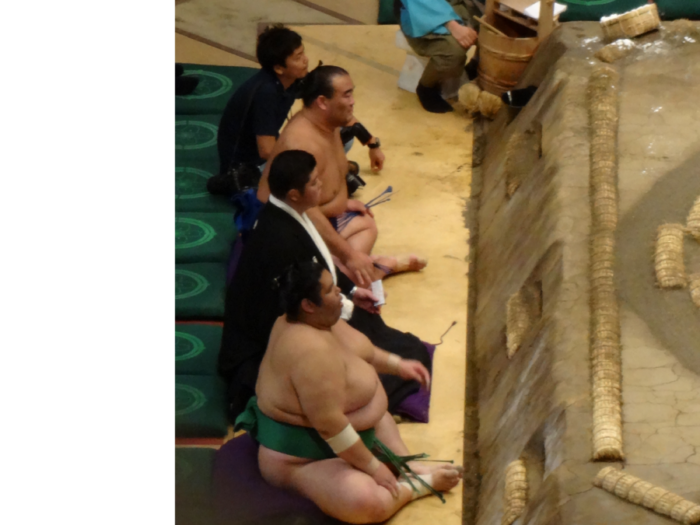
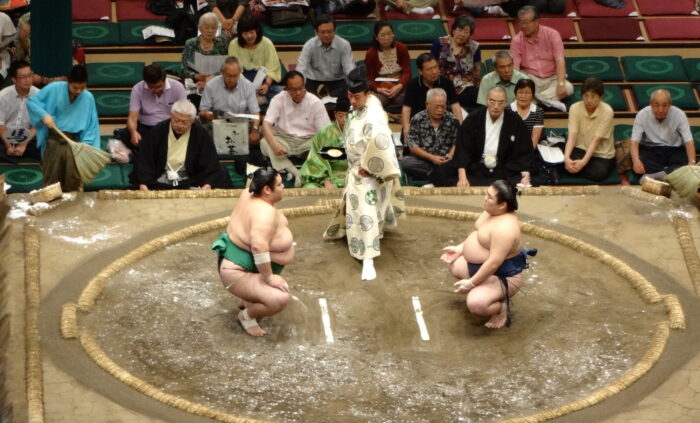
It is almost impossible to believe the doyho is made of hard clay, especially when you see these massive men come crashing down time and again!
There is a large ‘A-frame’ roof suspended over the ring which lends the look of a shrine to this indoor spectacle. Giant tassels are hung from each corner to signify the seasons and there is a large Japanese flag perfectly centered over the top of the roof.
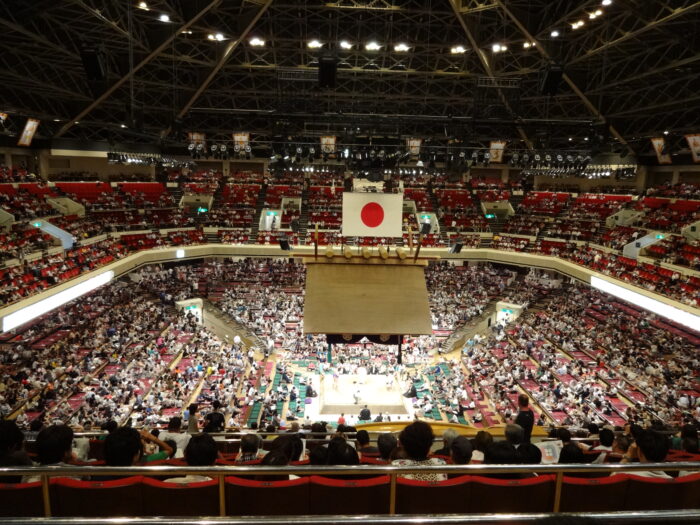
Each of the four sides facing North, South, East and West have special meaning and dictate where the teams enter from and which direction individuals face for the matches. Spectators who sit facing North & South get to see these giants crashing into each other after exploding off the line. The East & South view is pretty much ‘butts’ until the action starts ; )
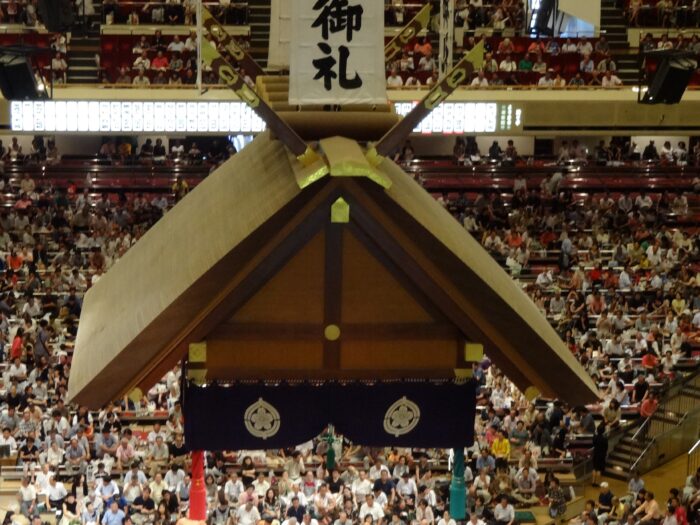
The object of the match is to force out, or take down your opponent and this tends to look more like a ‘shoving’ match than anything.
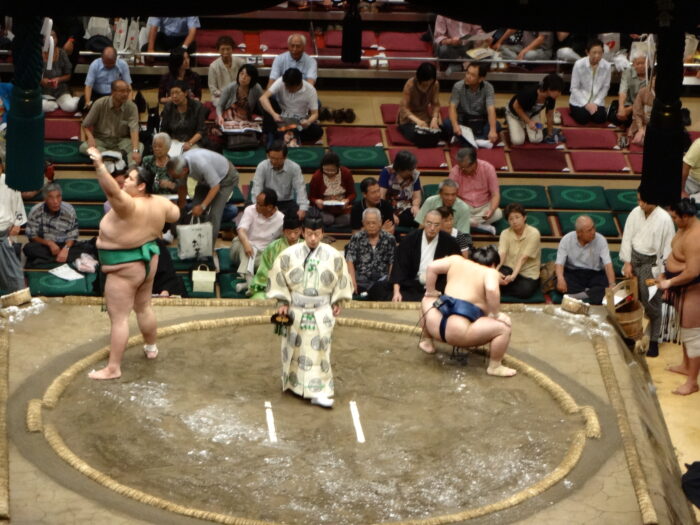
Other than the soles of the feet, no other part of the body can touch the mat. The first ‘Rikishi’ (competitor) who leaves the circle or touches the mat with anything besides his feet, loses.
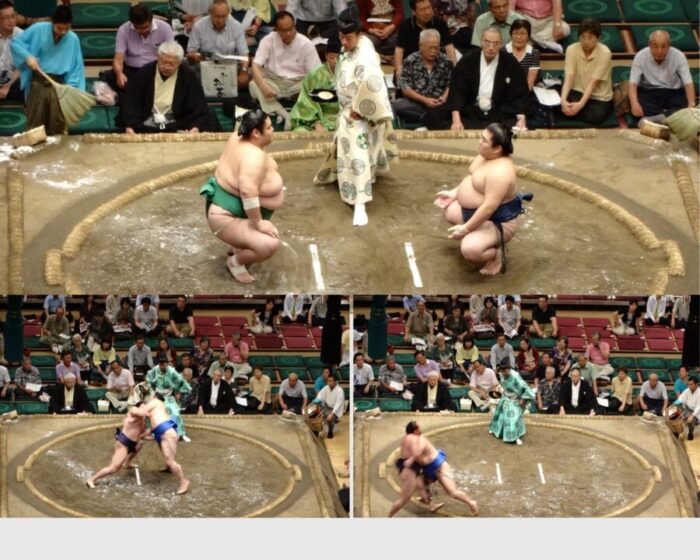
The end of a given match can go almost unnoticed with a quick shuffle outside the perimeter, to an edge of your seat skirmish with a painful two-man pile up! That’s when I decided the doyho must be solid concrete to withstand this force! Of course it isn’t concrete, just hard packed clay!
Before all the excitement of the actual match, a series of rituals occur and it goes something like this…
When two opponents enter the ring they face each other from either side of the center lines, crouch down and clap to get the attention of the Gods. They then extend their arms with palms facing upward to show that he conceals no weapons.
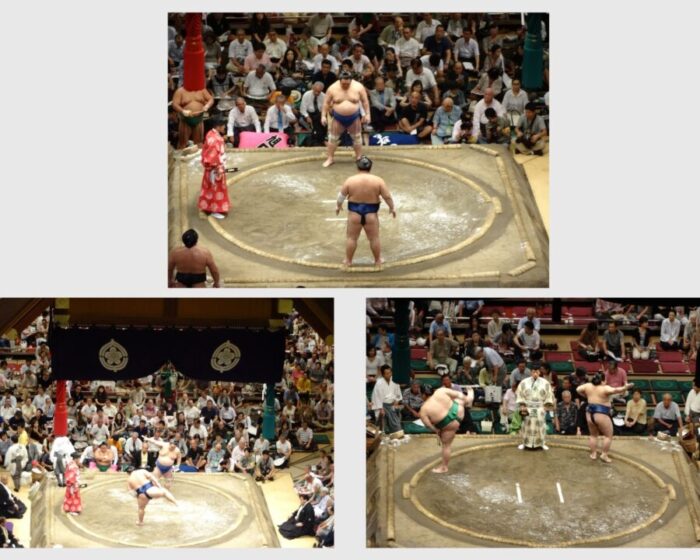
The lifting of the legs to either side is followed by a heavy stomp which is meant to drive out any evil. This practice will take place before all matches and it is immediately followed by what I call peacocking …. as they shuffle back and forth with intermittent couching, leaning, standing and even false charges.
Eventually they get behind the center lines and face each other in what looks like the start of the match…. but wait! There’s more!
More crouching, leaning, standing and pacing but this time they also lumber over to their respective corners while slapping thighs and arms! Apparently this is meant to cleanse the mind and body! They gargle and spit, wipe faces and pits and the upper ranking men have the privilege of throwing handfuls of salt in the ring to purify it and help guard against injury. Then the whole thing starts all over again…..!
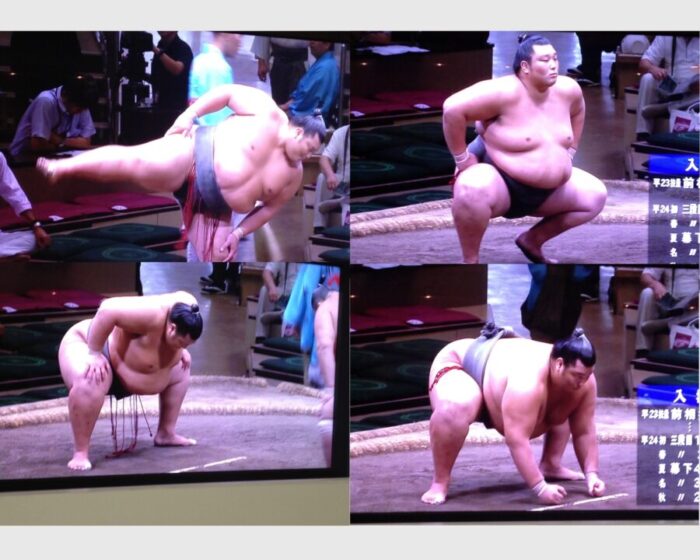
The closer these guys are to top ranks, the more flamboyant and drawn out these 3-4 displays are, which cannot last more than 4 minutes. In early sumo there was no time limit for these bouts of intimidation and there were times when the matches were even suspended! In 1928, they put a 10 minute rule into effect which was lowered three more times to what is now just 4 minutes, but it feels more like 10!
So, when at last they are crouched forward in the ready position while supporting themselves on their fists, and they finally burst forward plowing into each other, the force of this collision can be both heard and seen as bodies slam together and skin literally ripples….
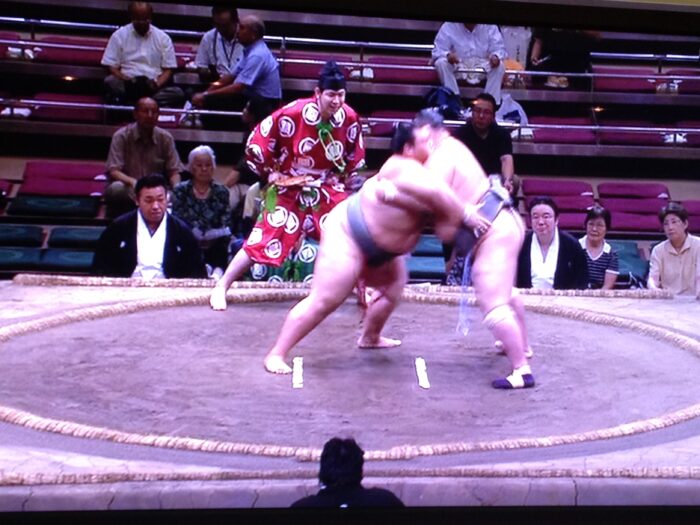
It is actually quite exciting to watch a good match and see these giant men go down in pile-ups, get full body slams and even roll right over backwards into the first row of judges and other contestants. Several times it looked like the skinny little ref was running for his life!
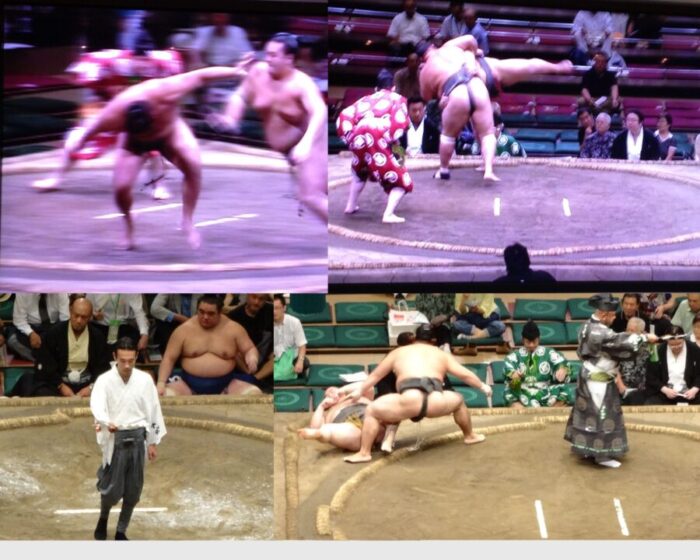
By the way, there are no weight classifications in professional sumo so it is not unusual to see little guys matched up against giants!
Takanoyama, Czech
29yrs 212lb – 6”1”
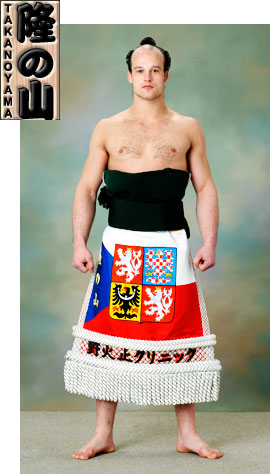
‘Shiratsuka’ Japan
28yrs 472lb – 6’3”
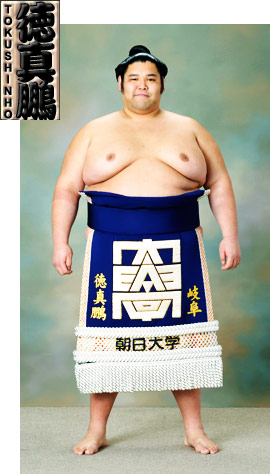
So over the course of the 15 day tournament, each ‘Rikishi’ will fight once a day with a new opponent. The winner is determined after the last match on the final day when the ‘Emperor’s Cup’ is bestowed upon the man with the most wins over losses during the tournament.
There are three additional prizes up for grabs; one for the Rikishi who upset the most champions (I like that one!), another for displaying the best winning spirit and the final for utilizing the best technique. In order to be eligible for these awards, the competitor must have won at least 8/15 of his matches.
This explains a lot of the attitude and peacocking I referred to, which is estimated to be about 80% of most matches! Once they do crash together in the center of the ring the match is usually over inside 60 seconds!
Currently, there are 800 professional sumo wrestlers here in Japan and I was shocked to learn they are not all Japanese! The current roster includes men from Russia, Czech Republic, Bulgaria, Mongolia, Estonia, Georgia and even Brazil!
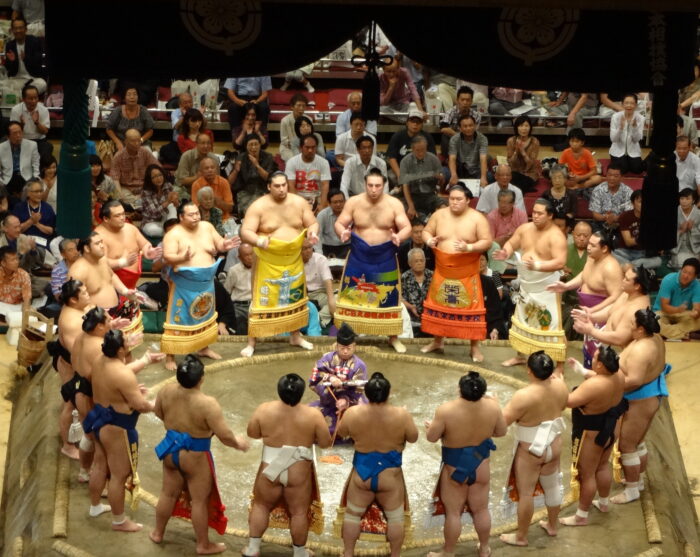
Their ranking is re-evaluated after each Grand Tournament and there are 8-levels plus a coveted top spot very few ever attain. The competitors who are in the bottom four levels are usually the newer guys who are working their way up the ranks, and they do not get to wrestle every day of the tournament.
Yokozuna ‘Hakuho’ Mongolia 27yrs, 153kg 6’4″ (Still reining champ in 2021!)
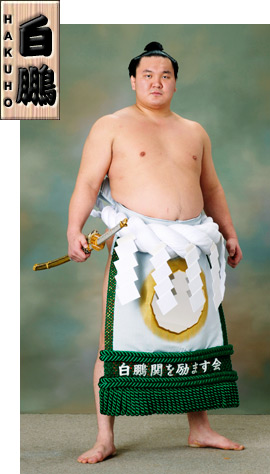
The top rank of ‘Yokozuna’ or Grand Champion is a very special distinction which only 69 men have attained over the past 300 years! It is interesting to note that is was only in 1993 that ‘gaijin’ (non-Japanese) were deemed worthy enough to be endowed with such an honor. The Rikishi’s ascent to this coveted stature begins with having won 2 consecutive Grand Tournaments while maintaining the previous title of ‘Ozeki’. The person who meets this basic requirement is then scrutinized by the Sumo Kyokai, who must decide if he is of sufficient dignity & grace to hold such an exalted position!
The criteria for this judgement of character are so vague that there have been periods of time where there was no reining Yokozuna, and as many as four at the same time! Once attained, this Champion can never be stripped of his prestige, even for poor sportsmanship or losses. That said, when his performance begins to wane, or if there is a scandal, he is expected to retire…, no doubt to the lap of luxury! Oh, and if the exaltation of becoming Yokozuna is not quite enough, perhaps the $30k/month (usd) can give sufficient motivation…
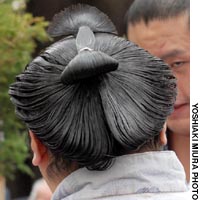
‘Oicho’ style Chonmage (haircut).
To the trained eye the rank of a Rikishi can be at least partly determined by how the hair is worn. Only the accredited men in the upper ranks are entitled to wear a traditional, strict top knot while competing. The aspiring hopefuls are fated to wear a simple, plain style with paper strings. The styles are straight out of the Edo Period and are maintained for tradition and head protection!
In addition to their hair style, their rank is also glimpsed by the order they enter the dohyo when the team enters the ring as a group for the short ceremony prior to the multiple matches in each division. The men at the bottom lead the precession which ends with the top athlete on that team, in that division.
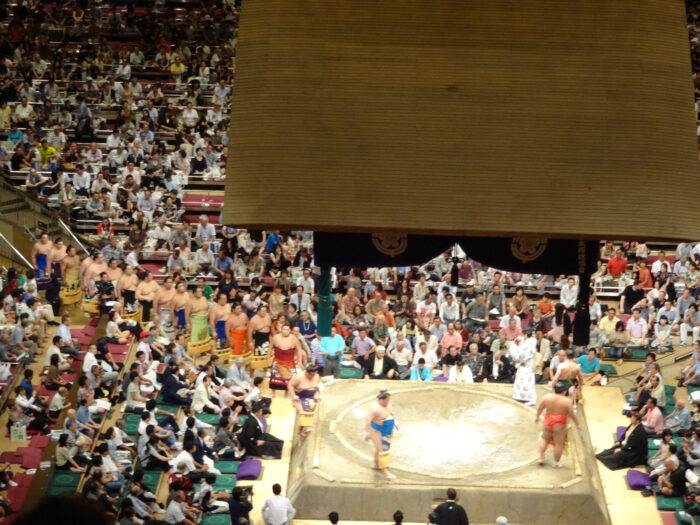
They are all adorned with ceremonial aprons made of beautiful silk which are intricately embroidered and stitched with meaningful designs, and finished off with heavy twisted fringe, often in gold! These aprons are estimated to be worth 400,000Yen – 500,000Yen which is $5,000-$6,500USD! (July 2021 the Yen is worth A LOT less at $3,600 – $4,500USD)
The loincloth they wear for the match is made of approx 10 yards (by 2 feet wide) of heavy silk that is folded and wrapped many times. Its assembly is a fine art because it’s said that sumo is won by using 1 of more of than 70 ‘winning tricks’ which mostly involve gripping the loincloth in order to maneuver the opponent.
We noticed the higher ranking men often had long strings hanging off the front of the wrap. They are stiffened up with glue to give them a stick like appearance and are purely ornamental.
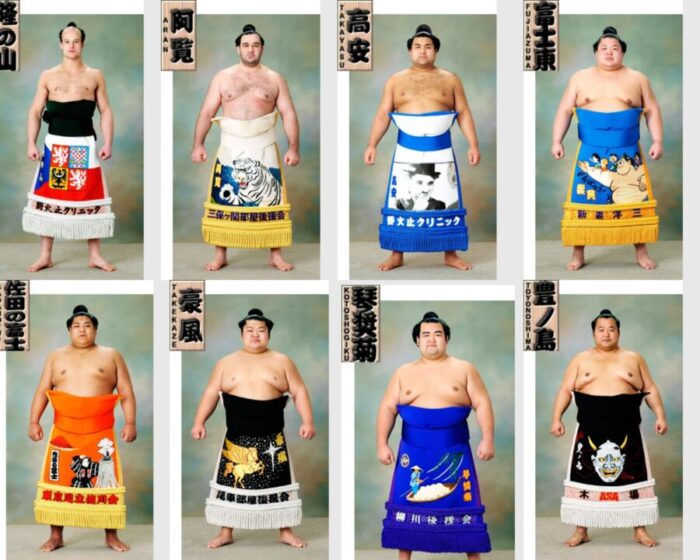
The days events are finished off with a specially chosen, mid-ranking Rikishi who preforms the bow twirling ceremony. Back in the Edo Period, the winner was awarded a bow and to express his satisfaction for his performance he would preform a ‘bow dance’. Sounds a bit like the touchdown dance we see in American Football, without the knee-knocking!
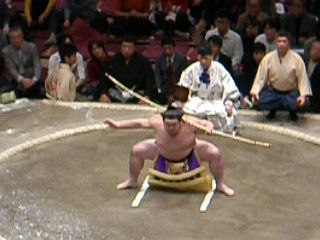
The refs are very colorful in their Samurai style Kimonos and only the highest ranking referee can officiate a match with a Grand Champion. Only the high ranking refs have the right to wear white split-toe socks, all others are barefoot. In addition to the referee, there are 4 judges seated on each of the sides of the dohyo and they will be called upon in case of any discrepancies where they can use their power to over-rule or even declare a re-match. They wear formal, black kimonos and look like they are sleeping most of the time!
Fascinating and highly recommended! Yummy snacks too!
Bye for now.
Originally From September 2012
entrepreneurship female entrepreneurs living in Japan


Leave a Reply